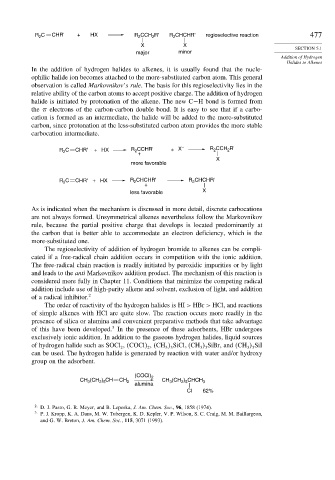Page 496 - Advanced Organic Chemistry Part A - Structure and Mechanisms, 5th ed (2007) - Carey _ Sundberg
P. 496
C CHR' + HX CCH R' R CHCHR' regioselective reaction 477
R 2 R 2 2 2
X X
SECTION 5.1
major minor
Addition of Hydrogen
Halides to Alkenes
In the addition of hydrogen halides to alkenes, it is usually found that the nucle-
ophilic halide ion becomes attached to the more-substituted carbon atom. This general
observation is called Markovnikov’s rule. The basis for this regioselectivity lies in the
relative ability of the carbon atoms to accept positive charge. The addition of hydrogen
halide is initiated by protonation of the alkene. The new C−H bond is formed from
the electrons of the carbon-carbon double bond. It is easy to see that if a carbo-
cation is formed as an intermediate, the halide will be added to the more-substituted
carbon, since protonation at the less-substituted carbon atom provides the more stable
carbocation intermediate.
R C CHR' + HX R 2 CCHR' + X – R CCH R'
2
2
2
+
X
more favorable
R C CHR' + HX R CHCHR' R CHCHR'
2
2
2
+
less favorable X
As is indicated when the mechanism is discussed in more detail, discrete carbocations
are not always formed. Unsymmetrical alkenes nevertheless follow the Markovnikov
rule, because the partial positive charge that develops is located predominantly at
the carbon that is better able to accommodate an electron deficiency, which is the
more-substituted one.
The regioselectivity of addition of hydrogen bromide to alkenes can be compli-
cated if a free-radical chain addition occurs in competition with the ionic addition.
The free-radical chain reaction is readily initiated by peroxidic impurities or by light
and leads to the anti Markovnikov addition product. The mechanism of this reaction is
considered more fully in Chapter 11. Conditions that minimize the competing radical
addition include use of high-purity alkene and solvent, exclusion of light, and addition
of a radical inhibitor. 2
The order of reactivity of the hydrogen halides is HI > HBr > HCl, and reactions
of simple alkenes with HCl are quite slow. The reaction occurs more readily in the
presence of silica or alumina and convenient preparative methods that take advantage
3
of this have been developed. In the presence of these adsorbents, HBr undergoes
exclusively ionic addition. In addition to the gaseous hydrogen halides, liquid sources
of hydrogen halide such as SOCl , COCl , CH SiCl CH SiBr, and CH SiI
3 3
2
2
3 3
3 3
can be used. The hydrogen halide is generated by reaction with water and/or hydroxy
group on the adsorbent.
(COCl) 2
CH (CH ) CH CH 2 CH (CH ) CHCH 3
3
2 5
3
2 5
alumina
Cl 62%
2 D. J. Pasto, G. R. Meyer, and B. Lepeska, J. Am. Chem. Soc., 96, 1858 (1974).
3
P. J. Kropp, K. A. Daus, M. W. Tubergen, K. D. Kepler, V. P. Wilson, S. C. Craig, M. M. Baillargeon,
and G. W. Breton, J. Am. Chem. Soc., 115, 3071 (1993).

